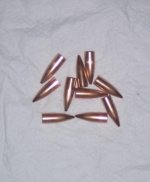T
TnTom
Guest
When a jacketed bullet is made (hpbt) where does the excess accumulate"? At the meplat or bullet base.
Is the ogive a "distance"? I'm thinking it begins at the end of the body diameter and ends at the tip of the cone?
Is datum a circle somewhere along the ogive? Can datum be any circle along that distance or ogive? Ideally would it be the circle the same diameter of that point in the chamber where the free bore ends and the rifling begins?
Who could I speak to and clear up some daunting questions that I will spare everyone here from?
I;m trying to clear up in my head some variations I see in a group of bullets. Im thinking these "competition" bullets are coming out of mutiple cavities at least. It has nothing to do directly with the meplat that could be cured by trimming it.
When a jacket is joined to a core can the core move as its swagged and reflect variation Im detecting when I measure from a point on the ogive the base of the bullet?
Is the ogive a "distance"? I'm thinking it begins at the end of the body diameter and ends at the tip of the cone?
Is datum a circle somewhere along the ogive? Can datum be any circle along that distance or ogive? Ideally would it be the circle the same diameter of that point in the chamber where the free bore ends and the rifling begins?
Who could I speak to and clear up some daunting questions that I will spare everyone here from?
I;m trying to clear up in my head some variations I see in a group of bullets. Im thinking these "competition" bullets are coming out of mutiple cavities at least. It has nothing to do directly with the meplat that could be cured by trimming it.
When a jacket is joined to a core can the core move as its swagged and reflect variation Im detecting when I measure from a point on the ogive the base of the bullet?




